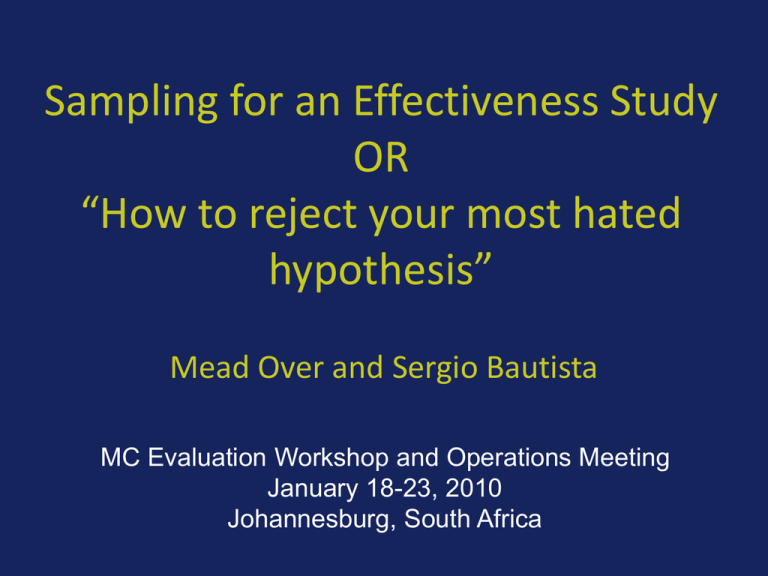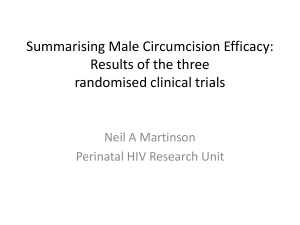Sample Size and Power Calculations
advertisement

Sampling for an Effectiveness Study OR “How to reject your most hated hypothesis” Mead Over and Sergio Bautista MC Evaluation Workshop and Operations Meeting January 18-23, 2010 Johannesburg, South Africa Hypothesis to reject • Circumcision has no impact • Circumcision has too little impact • Intensive Circumcision Program has no more impact than Routine Circumcision Program • Circumcision has no benefit for women Hypothesis to reject • Circumcision has no impact • Circumcision has too little impact • Intensive Circumcision Program has no more impact than Routine Circumcision Program • Circumcision has no benefit for women Efficacy Problem, we might get it wrong: Power Ho = MC does not impact HIV incidence State of the World MC does not change HIV incidence Estimate MC changes HIV incidence Power: probability Incorrect acceptance of MC does not Correct acceptance of that you don’t Ho fail to change HIV reject no impact, Ho (wrongly saying that MC incidence didn't work) you find impact Incorrect rejection of MC reduces Ho Correct rejection of Ho HIV incidence (wrongly saying MC did work) Confidence, power, and two types of mistakes • Confidence describes the test’s ability to minimize type-I errors (false positives) • Power describes the test’s ability to minimize type-II errors (false negatives) • Convention is to be more concerned with type-I than type-II errors – (ie, more willing to mistakenly say that something didn’t work when it actually did, than to say that something worked when it actually didn’t) • We usually want confidence to be 90 – 95%, but will settle for power of 80 – 90% Power • As power increases, the chances to say “no impact” when in reality there is positive impact, declines • Power analysis can be used to calculate the minimum sample size required to accept the outcome of a statistical test with a particular level of confidence The problem All men in the country, 20 years Time of Experiment Impact? Impact! 1 person, 1 year Sample Size The problem Time of Experiment Sample Size The problem • In principle: – The minimum sample size – The minimum observational time – The maximum power • So we are confident enough about the difference we find, at minimum cost The problem Time of Experiment Not enough confidence Sample Size The problem Time of Experiment Enough confidence Sample Size The problem Time of Experiment Sample Size The problem Minimum Sample Size Time of Experiment Time Constraint (usually external) Sample Size Things that increase power • More person-years – More persons – More years • Greater difference between control and treatment – More effective intervention – Control has no greater incidence than general population • Clustering: Maximize independence of individuals – Increase number of clusters – Minimize intra-cluster correlation Power is higher with larger incidence in the control group or greater effect Gaining Precision Effectiveness (% reduction In HIV incidence) Estimated Average 66 60 Precision we got 38 N in efficacy trial Person-Years Gaining Precision Effectiveness (% reduction In HIV incidence) 80 66 60 REAL Could be even this 38 15 N in efficacy trial Person-Years Gaining Precision Effectiveness (% reduction In HIV incidence) 80 REAL 66 60 38 15 N in efficacy trial Person-Years Gaining Precision Effectiveness (% reduction In HIV incidence) 80 66 60 38 REAL 15 N in efficacy trial Person-Years 20 40 Power is 68% 0 Frequency 60 1,000 efficacy studies when the control group incidence is 1% 0 .005 Reduction on incidence .01 .015 -.005 0 .005 Reduction on incidence .01 .015 40 20 0 Frequency 60 -.005 80 1,000 efficacy studies when the control group incidence is 5% 40 0 20 Frequency 60 Power is 85% 0 .02 .04 Reduction on incidence .06 .08 -.02 0 .02 .04 Reduction on incidence .06 .08 40 20 0 Frequency 60 80 -.02 Sampling for efficacy Population of interest: HIV negative men Controls Respondents Treatment Relevant characteristics Sample: Inclusion Criteria Effectiveness Less effective intervention - less impact 60% Effectiveness 20% Effectiveness Less effective intervention - less cost-effective 60% Effectiveness 20% Effectiveness Hypothesis to reject • Circumcision has no impact • Circumcision has too little impact • Intensive Circumcision Program has no more impact than Routine Circumcision Program • Circumcision has no benefit for women Differences between effectiveness and efficacy that affect sampling • Main effect on HIV incidence in HIV- men – Null hypothesis: impact > 0 (+) – Effect size because of standard of care (+) • Investigate determinants of effectiveness – Supply side (+ / -) – Demand side (+ / -) • Investigate impact on secondary outcomes and their determinants (+ / -) • Seek “external validity” on effectiveness issues Power increases with sample size Effectiveness (% reduction In HIV incidence) 80 66 60 38 20 15 N to be able to reject <20 Person-Years Sampling for effectiveness Population of interest: HIV negative men Control Respondents Treatment Sample Sampling frame: All men (+ and -) Relevant characteristics Two levels of effectiveness Effectiveness (% reduction In HIV incidence) 80 REAL 1 66 60 38 REAL 2 15 N to detect difference between 1 and 2 Person-Years Sampling for effectiveness Population of interest: HIV negative men Control Intensity 1 Respondents Intensity 2 Sample Sampling frame: All men (+ and -) Relevant characteristics Sampling methods for effectiveness • Probability sampling – Simple random: each unit in the sampling frame has the same probability of being selected into the sample – Stratified: first divide the sampling frame into strata (groups, blocks), then do a simple random sample within each strata – Clustered: sample clusters of units. Eg. villages with all the persons that live there • One stage: Random sample of villages, then survey all men in selected villages • Two stage: Random sample of villages, then random sample of men in selected villages Cluster Sampling Design Cluster Sampling • In some situations, individual random samples are not feasible – When interventions are delivered at the facility/community level – When constructing a frame of the observation units may be difficult, expensive, or even impossible • Customers of a store • Birds in a region – When is of interest to identify community level impact – When budget constraints don’t allow it M.K. Campbell et al. Computers in Biology and Medicine 34 (2004) 113 – 125 Clustering and sample size • Clustering reduces efficiency of the design – Standard sample size calculation for individualbased studies only accommodate for variation between individuals – In cluster studies, there are two components of variation • Variation among individuals within clusters • Variation in outcome between clusters Clustering and sample size • Individual-based studies assume independence of outcomes among individuals • In cluster randomization: – Individuals within a cluster are more likely to be similar • Measure of this intracluster dependence among individuals is ICC – Based in within-cluster variance • High when individuals in cluster are more “similar” • Not taking ICC into account may lead to underpowered study (too small sample) Taking ICC into account • In a cluster randomized design, in order to achieve the equivalent power of a individual random study, sample size require to be inflated by a factor: Deff = 1 + (ñ – 1) ρ to consider cluster effect • ñ = average cluster size • ρ = ICC • Assuming clusters of similar size How big is the impact of cluster design on sample size Effectiveness (% reduction In HIV incidence) 12 clusters 6 clusters 20 N to be able to reject <20 Person-Years When 19,950 individuals are in 15 clusters 1000 draws of the impact (larger is better) Population incidence in control group: .02 Effect size: .2 ; Intracluster correlation: 0.04 20 40 Power is 60 % 0 Frequency 60 Significant differences (p<.05) -.005 0 .005 Reduction on incidence .01 .015 .01 .015 40 20 0 Frequency 60 Insignificant differences (p>.05) -.005 0 .005 Reduction on incidence Number of clusters: 15 ; cluster size: 1330 ; years of study: 5 Person-years of study: 19,950 When 19,950 individuals are in 150 clusters 1000 draws of the impact (larger is better) Population incidence in control group: .02 Effect size: .2 ; Intracluster correlation: 0.04 20 40 60 80 Power is 97 % 0 Frequency Significant differences (p<.05) 0 .002 .004 .006 Reduction on incidence .008 .01 .008 .01 20 40 60 80 0 Frequency Insignificant differences (p>.05) 0 .002 .004 .006 Reduction on incidence Number of clusters: 150 ; cluster size: 133 ; years of study: 5 Person-years of study: 19,950 Increasing sample size • Increasing the number of clusters vs increasing the number the individuals per cluster • Increasing the number of clusters has a much stronger effect on power and confidence – Intuitively, the sample is the number of units (clusters) at the level where the random assignment takes place. It is not the same as the number of people surveyed • Challenge is to engineer the logistics to to maximize the number of clusters, given How big is the impact of cluster design on sample size Power 10 clusters 5 clusters 2 clusters N per cluster Impact on costs? Things that affect costs • • • • Including HIV positive men Including women Prevalence of HIV Length of questionnaire – To measure more outcomes – To measure implementation of intervention and costs • For cost-effectiveness • For control quality and other characteristics of the intervention Sampling for effectiveness Population of interest: HIV negative men Control Intensity 1 Intensity 2 Sample Sampling frame: All men (+ and -) Relevant characteristics Some Scenarios • 150 clusters, 100 men per cluster • Including women double number of HIV tests • Low and High prevalence additional men to be surveyed • High, medium, low cost – Dispersion of clusters distance among them – Length of questionnaire time in fieldwork, data collection staff Total Cost of the Survey Under Different Scenarios 150 clusters, 100 men per cluster 6,000,000 5,000,000 4,000,000 3,000,000 2,000,000 1,000,000 0 High Cost Medium Low Cost Cost Low Prevalence High Cost Medium Low Cost Cost High Prevalence Not Including Women High Cost Medium Low Cost Cost Low Prevalence High Cost Medium Low Cost Cost High Prevalence Including Women Conclusions • Philosophy of sample design is different for efficacy and effectiveness studies – Efficacy: narrow & deep – Effectiveness: broad & shallow • Many of the special requirements of effectiveness sampling will increase sample size • Clustering reduces data collection costs but at a sacrifice of power • Survey costs also affected – Number of indicators collected – Number of non-index cases interviewed • Most cost-effective way to reject your “hated hypothesis” is through randomized, efficeintly powered, sampling






